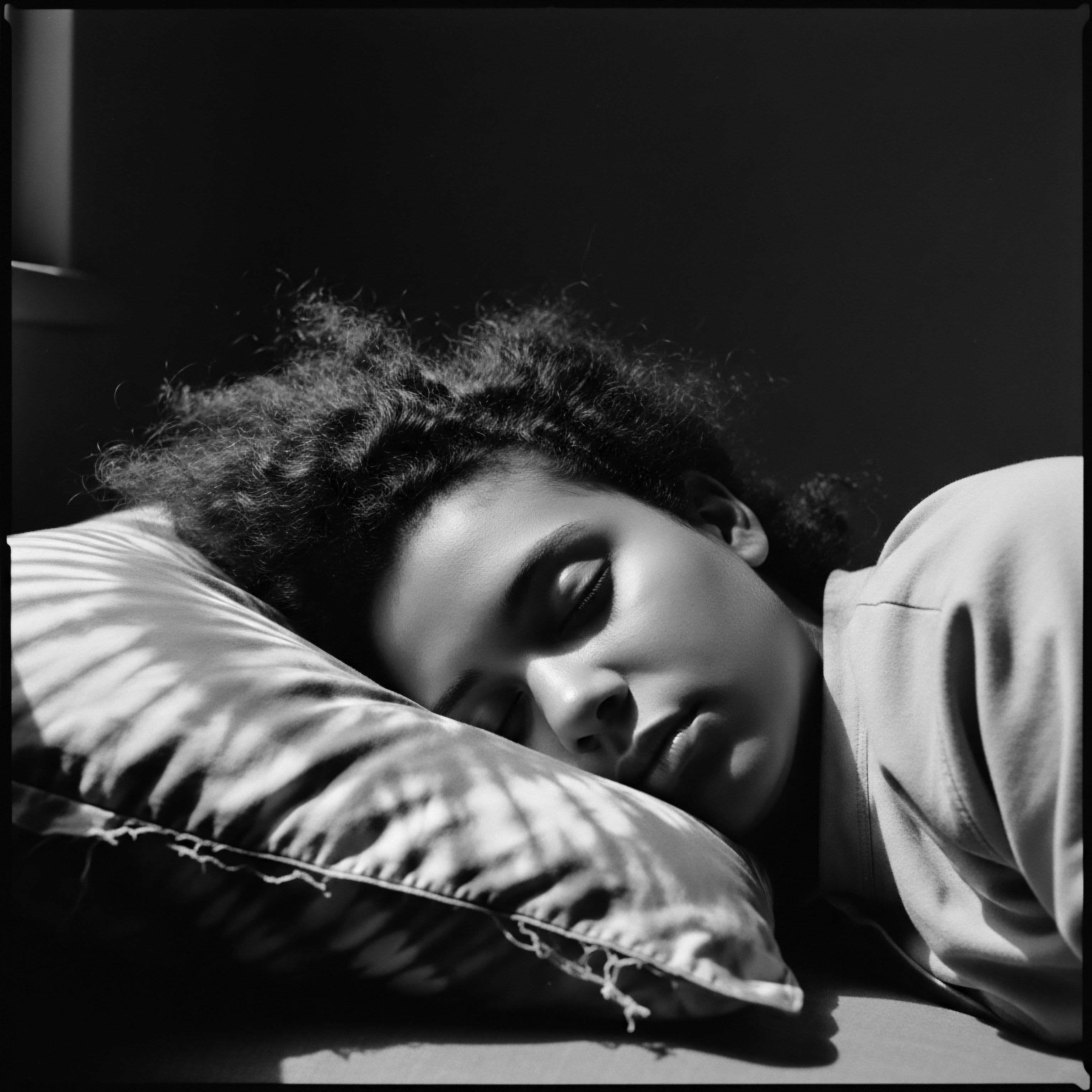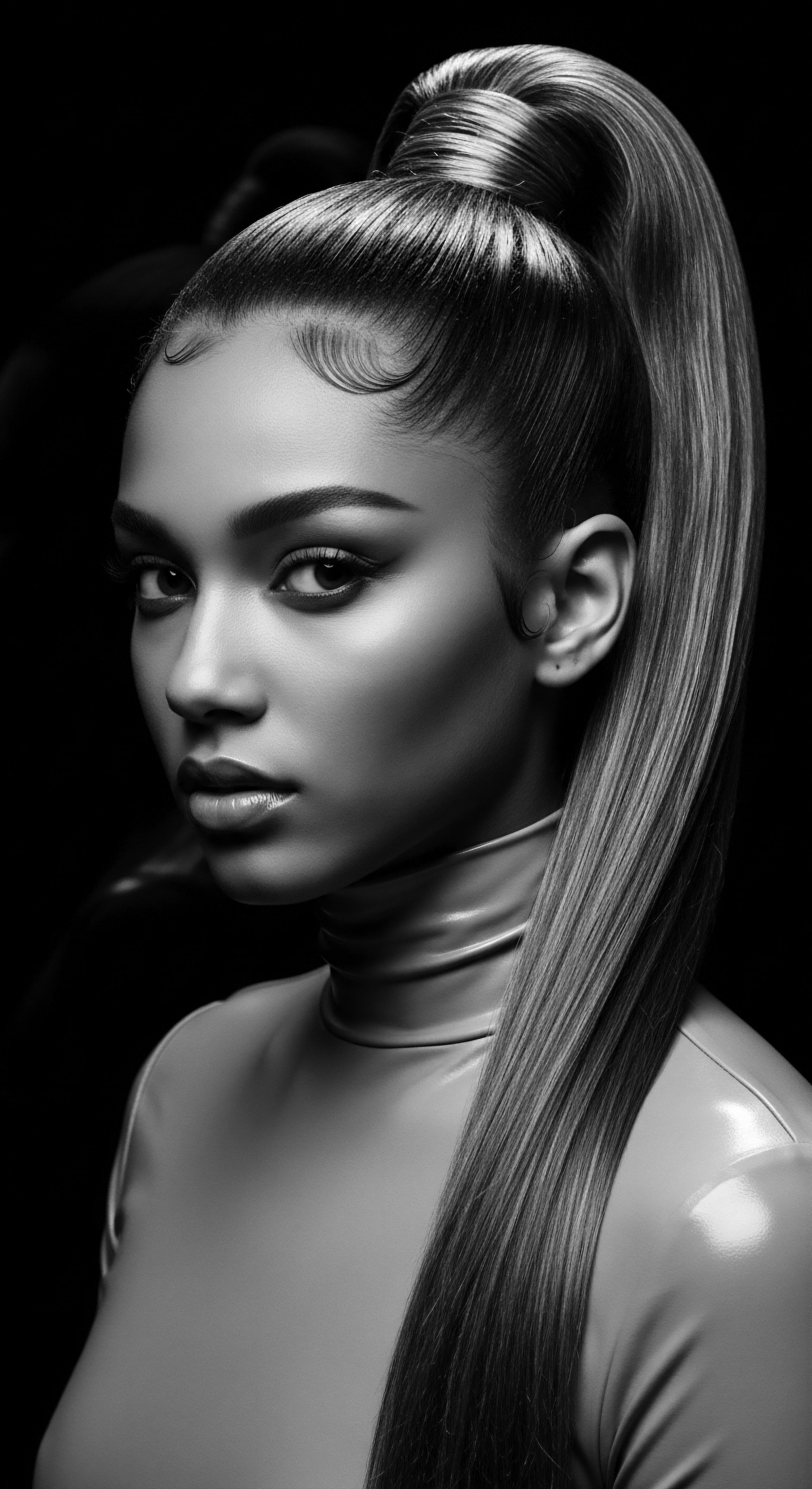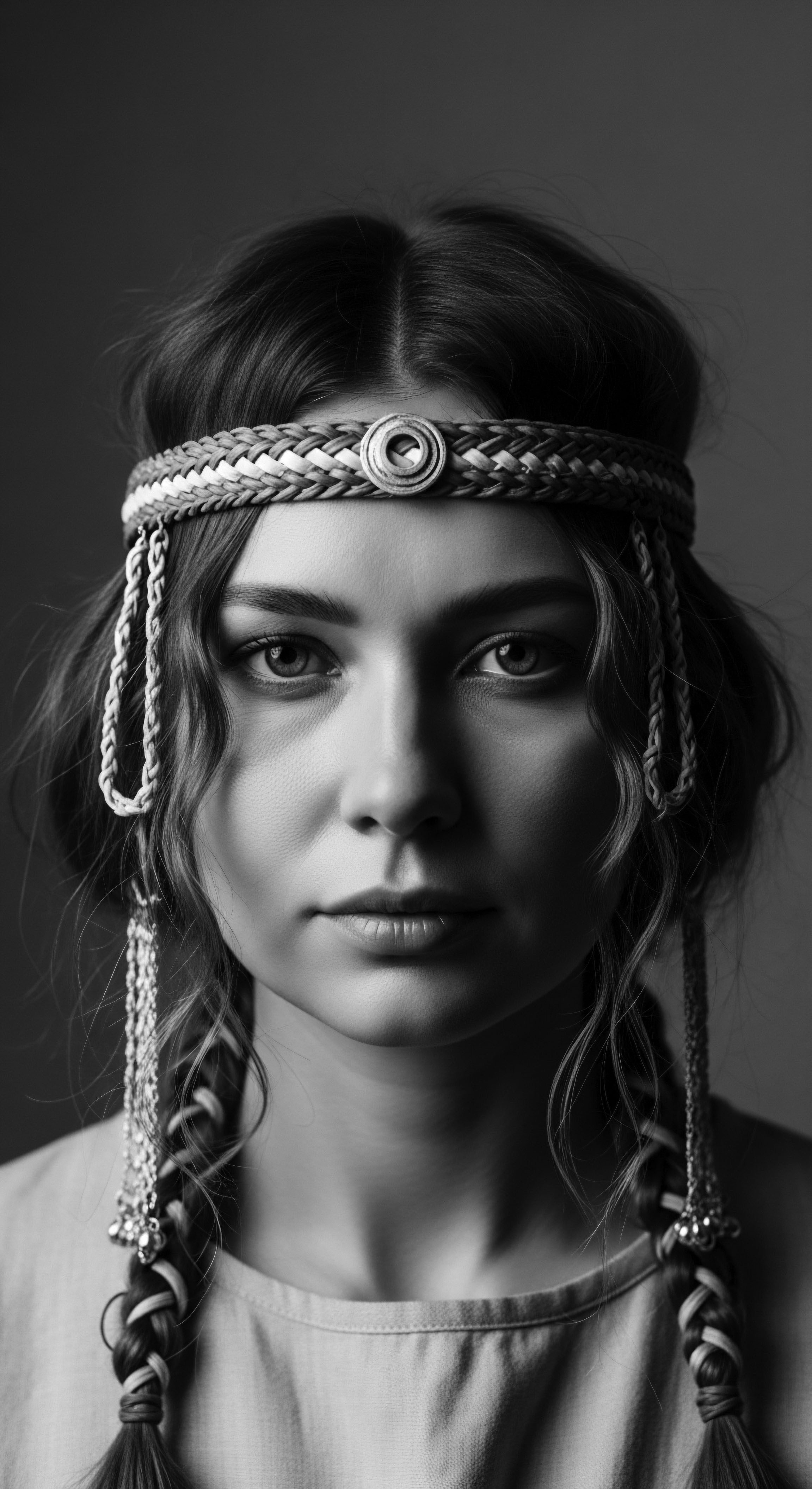
Roots
To journey back into the heart of what botanical heritage defined ancient hair rituals for coily strands, we must first allow ourselves to remember the soil from which our hair traditions grew. Imagine the touch of sunlight on scalp, the whisper of ancient winds through dense, verdant landscapes, and the hands of ancestors tending to strands with wisdom born of millennia. For those with coily hair, this connection to the earth and its offerings is not a distant concept; it is an echo within each curl, a memory in every coil.
This exploration reaches beyond mere cosmetic practices; it delves into a deep cultural lineage, a living chronicle written in the very structure of our hair. It is a story of resilience, identity, and profound connection to the natural world, particularly for Black and mixed-race communities, whose heritage of hair care is a testament to survival and beauty.

The Genesis of Coily Strands
The unique architecture of coily hair, with its elliptical follicle shape and varied curl patterns, determines its particular needs and strengths. This biological blueprint, passed down through generations, meant that ancient peoples had to learn from their immediate environment how to best care for and adorn these strands. The very nature of coily hair—its ability to retain styles, its natural volume, its resistance to breakage when properly tended—guided ancestral hands towards specific botanical allies.
Early societies understood that hydration was paramount for these curls, recognizing the inherent dryness of the hair type and the environmental factors that could exacerbate it. They observed how certain plants offered moisture, provided slip for detangling, or sealed the cuticle, laying the foundation for sophisticated hair care systems.
Understanding the fundamental biology of textured hair forms the ground from which our appreciation for ancient practices can truly blossom. Unlike straight hair, coily strands typically possess fewer cuticle layers, rendering them more prone to moisture loss and dryness. This structural reality shaped ancestral botanical selections. Early innovators sought plants rich in emollients and humectants, recognizing their ability to draw moisture from the air and seal it within the hair shaft.

How Did Ancient Peoples Identify Hair Needs?
Ancient civilizations did not possess microscopes or chemical analysis tools. Their understanding of hair health stemmed from keen observation, trial, and generational knowledge transmission. They learned through direct experience which plant preparations softened hair, which cleansed without stripping, and which offered protection from the elements.
This empirical wisdom, honed over countless seasons, became the bedrock of their hair care regimens. The efficacy of a plant was often judged by the tangible results it produced ❉ increased shine, reduced breakage, enhanced manageability, or relief from scalp discomfort.
Ancestral wisdom concerning coily hair care was a lived science, informed by acute observation of botanicals and their tangible effects on strands.
This knowledge was not merely practical; it was communal. Elders, particularly women, served as custodians of this wisdom, teaching younger generations the properties of local flora and the rituals for their application. The identification of hair needs was therefore a collective pursuit, rooted in shared experiences and transmitted through storytelling and demonstration.
- Shea Butter ❉ Derived from the nuts of the shea tree, indigenous to West Africa. Used for centuries to moisturize skin and hair, protecting from sun and environmental stressors. It provides deep hydration and acts as a sealant.
- Castor Oil ❉ A staple in ancient Egyptian hair care, valued for its moisturizing and strengthening properties. It was often blended with honey and other herbs to promote hair growth and add luster.
- Aloe Vera ❉ Celebrated in ancient Egypt and other cultures for its soothing and moisturizing qualities. It was applied to address scalp dryness and dandruff.

Ritual
From the foundational understanding of coily strands, we move into the vibrant sphere of ancient hair rituals themselves. These were not singular acts but often extended ceremonies, deeply embedded in the rhythm of daily life, communal bonds, and spiritual beliefs. Botanical elements were at the very core of these practices, transforming simple acts of cleansing and conditioning into profound expressions of self-care and cultural identity.
The preparations, application techniques, and even the moments shared during these rituals speak volumes about the reverence for hair across various ancient African societies and beyond. The selection of specific plants for particular steps in a hair regimen reveals a sophisticated understanding of their properties, long before modern chemistry could offer explanations.

Daily Practices, Sacred Connections
Ancient hair rituals for coily strands were often communal events, particularly for women. The act of cleansing, detangling, and styling became a space for bonding, storytelling, and the transmission of generational wisdom. These practices fostered connection between individuals, reinforcing social ties and cultural identity. Imagine a group of women, perhaps under the shade of a baobab tree, sharing laughter and counsel while meticulously tending to each other’s hair.
This was not just grooming; it was a living archive, a way of passing down history and values. The very cadence of the hands moving through coily strands, applying botanical preparations, spoke of a heritage of care.
The selection of botanicals was rarely arbitrary. Plants known for their cleansing saponins were used for washes, while those rich in mucilage provided slip for detangling. Emollient oils and butters sealed moisture, preventing the natural dryness of coily hair. These ancient practices show a remarkable empirical understanding of hair physics and chemistry.

What Plants Were Central to Ancient Cleansing?
Ancient civilizations did not have manufactured shampoos in the way we recognize them today. Their cleansing agents came directly from the earth, utilizing plants that naturally produce saponins, compounds that create a gentle lather and clean without harsh stripping. Other materials, such as specific clays, were also prized for their purifying abilities. These botanical cleansers were often prepared as infusions, decoctions, or pastes, tailored to specific hair needs and regional availability.
Ancient hair rituals were communal tapestries of care, where botanical preparations transformed self-tending into shared expressions of identity.
| Botanical Source African Black Soap (from plantain skins, shea tree bark) |
| Traditional Region West Africa |
| Hair Benefit Gentle cleansing, scalp purification, moisture retention. |
| Botanical Source Rhassoul Clay (Moroccan lava clay) |
| Traditional Region North Africa (Morocco) |
| Hair Benefit Draws impurities, purifies scalp, softens hair, improves manageability. |
| Botanical Source Ziziphus spina-christi (Christ's thorn jujube) |
| Traditional Region Northeast Africa (Ethiopia) |
| Hair Benefit Used as a shampoo, anti-dandruff properties, can be mixed with henna. |
| Botanical Source Ambunu (from the Ambunu plant) |
| Traditional Region Central Africa (Chad) |
| Hair Benefit Natural cleanser, detangler, soothes itchy scalp, addresses dandruff. |
| Botanical Source These earth-derived cleansers highlight ancestral ingenuity in maintaining healthy coily hair. |

Adornment and Protection
Beyond cleansing, botanicals played a pivotal role in styling and protecting coily hair. Oils and butters served as conditioning agents, providing slip for intricate braiding and twisting. They also acted as natural sealants, shielding strands from environmental aggressors like sun and dust.
Styles were not merely aesthetic; they carried social messages, communicated status, and served as protective measures. The ability of certain botanical extracts to provide hold, enhance shine, or strengthen hair allowed for the creation of enduring styles that were both beautiful and functional.
For instance, the women of the Himba people in Namibia traditionally use a paste called ‘otjize’, made from butterfat and ochre, with cleansing and conditioning plant extracts mixed in. This practice serves as a protective barrier against the sun and dryness, while also acting as a distinct cultural marker. Similarly, beeswax and other plant waxes might have been used to provide hold and definition for specific styles.

Relay
The botanical heritage defining ancient hair rituals for coily strands is not a static artifact of the past. Instead, it is a living, breathing lineage that has traveled across continents and generations, adapting and persisting even through profound societal shifts. This relay of knowledge, from elder to youth, from one community to another, forms a powerful testament to the enduring human need for connection, identity, and self-care. The nuanced understanding of plant properties, honed over millennia, continues to inform contemporary hair practices, often finding scientific validation in modern research.

The Enduring Wisdom
The transatlantic slave trade presented an unparalleled disruption to African cultural practices, including hair care rituals. Yet, amidst unimaginable adversity, enslaved Africans and their descendants demonstrated profound resilience in preserving these traditions. Though often stripped of their traditional tools and natural ingredients, they adapted, substituting what was available in their new environments while retaining the core principles of ancestral care. Hair braiding, for example, transformed from a social practice and status indicator into a coded language for survival and a symbol of resistance.
Rice and seeds were sometimes braided into hair for sustenance or to mark escape routes (Byrd & Tharps, 2001, p. 19).
This persistence underlines how deeply hair rituals were intertwined with identity and spirit. The act of tending to one another’s hair became a quiet, powerful assertion of self, a reclamation of dignity in dehumanizing circumstances. Communal grooming continued as a vital social activity, strengthening bonds that were essential for survival and collective resilience. This historical example underscores the profound socio-cultural significance of botanical heritage; it transcended mere aesthetics to become a vehicle for cultural survival.
The knowledge of how specific plants nurtured coily hair, how to prepare them, and the significance of their use was passed down, often orally, through families. This unwritten history, held within the memory of hands and the whisper of stories, ensured that the wisdom of ancient botanical practices continued to hydrate, protect, and adorn textured hair despite centuries of attempts to erase African heritage.

Can Modern Science Explain Ancient Botanical Efficacy?
Modern trichology and ethnobotanical studies now increasingly validate the efficacy of many traditional botanical practices. Compounds found in plants, once understood only through empirical observation, are now identified for their specific benefits. For instance, the high fatty acid content in shea butter (predominantly oleic acid, stearic acid, and linoleic acid) makes it an effective emollient, sealing moisture into the hair shaft.
Aloe vera’s soothing properties are linked to its polysaccharides and glycoproteins, which reduce inflammation and hydrate the scalp. Plants like soapberry (Reetha) and Shikakai, long used in Ayurvedic traditions for cleansing, contain saponins, natural surfactants that gently clean hair without stripping its natural oils.
The enduring legacy of ancient botanical hair rituals represents not just historical practices, but a continuous source of wisdom for textured hair care today.
This intersection of ancient wisdom and contemporary scientific understanding offers a compelling argument for revisiting botanical heritage. It is a dialogue across time, where the insights of our ancestors receive affirmation from modern laboratories, bridging cultural practices with current understanding of hair biology.
- Emollients ❉ Oils and butters like shea butter, coconut oil, and castor oil, rich in fatty acids, smooth the hair cuticle and seal in moisture, a property crucial for coily strands.
- Humectants ❉ Botanicals such as aloe vera and honey attract and retain moisture from the atmosphere, providing hydration to dry hair.
- Saponins ❉ Found in plants like soapberry and rhassoul clay, these natural compounds provide gentle cleansing without stripping the hair’s natural lipids.

Hair as a Living Chronicle
Hair, for many with coily textures, remains a profound living chronicle of personal and collective heritage. The choice to wear hair in its natural state, or in styles rooted in ancestral practices, speaks volumes about identity, self-acceptance, and a connection to a past that was resiliently preserved. Ancient botanical rituals, therefore, offer more than just hair care instructions; they are pathways to cultural affirmation, a tangible link to the ingenuity and spirit of those who came before. In a world that has often sought to diminish or erase textured hair, reclaiming and celebrating these botanical legacies becomes an act of profound self-love and cultural pride, shaping not only individual futures but also contributing to the collective story of Black and mixed-race beauty.

Reflection
The journey through the botanical heritage that defined ancient hair rituals for coily strands reveals a story far richer than mere grooming routines. It speaks to a deep, inherent wisdom held by our ancestors, a profound attunement to the earth’s rhythm and its generous offerings. Each botanical, whether a nourishing butter, a cleansing clay, or a strengthening herb, was a carefully chosen partner in the care of strands that were, and remain, sacred. This is the very Soul of a Strand, a quiet, insistent beat that connects us to a continuous lineage of care and cultural pride.
It is a living, breathing archive, not confined to dusty texts, but residing within the memory of our textures and the continuing practices of our communities. To understand this heritage is to honor the ingenuity, resilience, and beauty of those who, against all odds, preserved and passed down this profound wisdom. We carry their legacy in every curl, a testament to the enduring power of ancestral knowledge and the timeless bond between humanity and the green earth.

References
- Byrd, A. D. & Tharps, L. L. (2001). Hair Story ❉ Untangling the Roots of Black Hair in America. St. Martin’s Press, New York.
- Gallagher, J. T. Wood, W. B. & Miller, J. M. (2023). The Archaeology of Shea Butter. Journal of African Archaeology.
- Noudou, B. (2024). Cosmetopoeia of African Plants in Hair Treatment and Care ❉ Topical Nutrition and the Antidiabetic Connection? MDPI.
- Sharaibi, O. J. et al. (2024). Plants used for hair and skin health care by local communities of Afar, Northeastern Ethiopia. Ethnobotany Research and Applications, 29.
- Toumpi, A. et al. (2024). Ethnobotanical Survey of Medicinal Plants used in the Treatment and Care of Hair in Karia ba Mohamed (Northern Morocco). ResearchGate.
- Falconi, L. (2023). The Benefits of African Shea Butter in Skin Care and Hair Care Products. ResearchGate.
- Moussa, A. (2024). Ancient African Hair Growth Secrets That Easily Grow Healthiest Longest Natural Hair. YouTube.
- Adekola, S. (2024). Ancient Gems ❉ A Historical Survey of African Beauty Techniques. Obscure Histories.
- Adekola, S. (2024). The Globalization of Shea Butter. Obscure Histories.
- Okoro, N. (2023). The History and Cultural Significance of African Hair Braiding. Elom African Braids.
